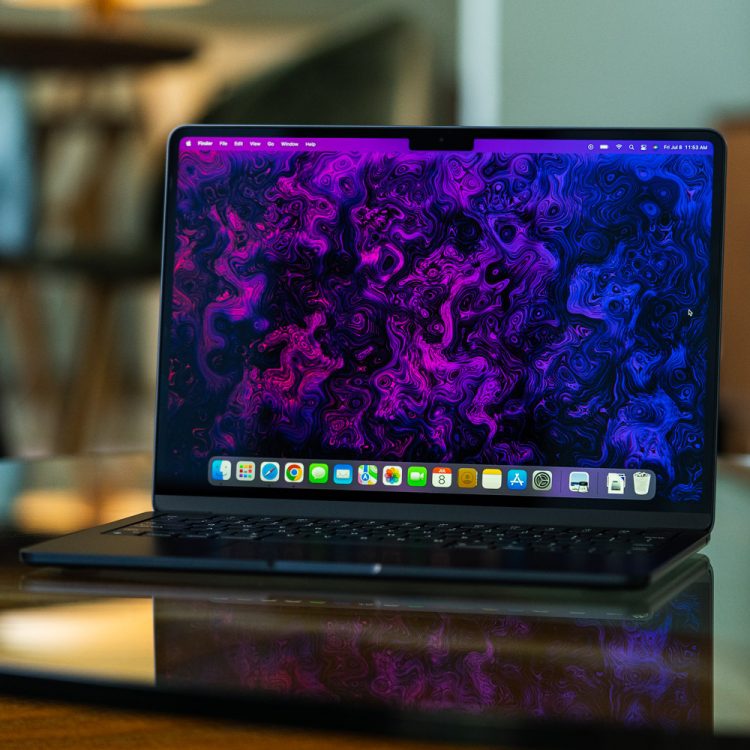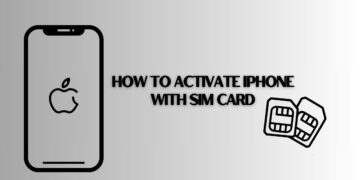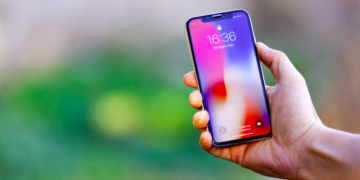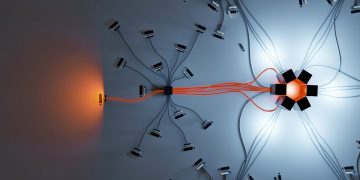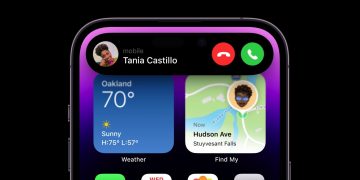After 14 years, three revisions, and two different processor architectures, the iconic wedge shape of the MacBook Air is now history. In its place is a MacBook Air with a completely new design that’s the same thickness from front to back. Virtually every aspect of the new MacBook Air has been updated or changed — it’s the biggest update to the Air since it originally debuted nearly a decade and a half ago.
These kinds of changes are a big deal because the Air is the default laptop option for millions of people. Beyond that, the Air sets the standard for thin and light laptops that every other manufacturer chases.
In addition to the design and hardware changes, this new Air has Apple’s latest in-house processor, the M2. It also comes with a higher price tag — it starts at $1,199, $200 more than the model that preceded it, and a model with a decent amount of storage runs $1,499 or more. As a result, Apple is keeping the prior M1 model in its lineup, specifically to provide an option for the many MacBook Air buyers that don’t want to spend much more than $1,000 on a new computer.
The M1 MacBook Air was (and still is) one of the most impressive laptops we’ve ever tested — Dieter Bohn called it “a triumph” at the time. That’s quite a bar to live up to, and with all of the changes Apple made to the M2 model, it’s fair to wonder if this new model can best the prior version.
For the most part, that answer is yes. But as they say, the devil’s in the details, and there are quite a few details to note here.
Good Stuff
- Thinner, lighter design
- Much-improved screen
- Much-improved webcam
- All-day battery life
- Great performance for most tasks
- MagSafe charging is extremely convenient
Bad Stuff
- More expensive
- Gets warm and throttles aggressively under intense workloads
- Base model has much slower storage
- Display notch gets in the way of menubar apps
- Midnight color gets covered in fingerprints
- Port options are still limited
The new MacBook Air borrows a lot of its design and shape from the MacBook Pro 14 and 16 that debuted late last year. It’s symmetrical and squared off, with a more brutalist presentation than prior MacBook Air models.
Yet it’s remarkably thin — just a smidge over 11 millimeters — and that thinness is immediately noticeable when you open the lid and start typing on it. It’s also noticed whenever you slot it into a bag or carry it around. The older MacBook Air’s tapered shape had less visual weight and may look thinner, but the new model is indeed slimmer than its predecessor.
It’s also slightly lighter, at 2.7 pounds vs. the older model’s 2.8. That’s not a huge difference, and the Air is far from the lightest computer you can buy, but it does make it extremely portable and easy to tote around wherever I need it.
:no_upscale()/cdn.vox-cdn.com/uploads/chorus_asset/file/23759760/bfarsace_190101_5333_0007.jpg)
The new Air loses the wedge shape but is actually thinner than the previous model.
In all, I’m a fan of this new design. It’s modern and refreshing and functionally works very well. Some might miss the wedge shape, but I’m not one of them. This new Air is a beautiful computer, and I think this design will work well for the next five (or possibly more!) years or so until Apple updates it again.
Unless you get the new Midnight color. This new color is gorgeous out of the box, with a deep blue-black finish that can change depending on the light. But as soon as you pick it up, it gets covered in greasy fingerprints that are a chore to clean off. It really mars what is otherwise a striking finish. Apple’s far from the only company to face this problem with dark aluminum — Razer’s laptops have been fingerprint magnets for years — but it’s enough of an issue that I wouldn’t buy the Midnight model. I’ve also had the opportunity to test a model in the silvery-gold Starlight color, and its surface stays fingerprint-free.
Despite that thinner profile and lighter weight, the new Air is no less solid or well-built than before. The chassis is stiff, the lid has next to zero flex, and it still can be opened with a single finger. Apple remains at the top of the field when it comes to build quality and fit and finish, and the new Air is no exception.
:no_upscale()/cdn.vox-cdn.com/uploads/chorus_asset/file/23759754/bfarsace_190101_5333_0001.jpg)
The new Midnight color option is a fingerprint magnet.
In addition to its shape, the new Air borrows the resurrected MagSafe charging connector from the MacBook Pro 14 and 16, which lets you charge the laptop without worrying that tripping over the cable will send the computer tumbling to the floor. It even comes with a color-matched braided cable in the box, something you don’t get on the more expensive Pro models.
Apple’s also giving you a choice when it comes to chargers. The base model Air comes with the familiar 30W brick that’s been around for years. But the step-up models provide a choice between a new compact 35W charger with two USB-C ports or a larger and more powerful 67W brick borrowed from the MacBook Pro line. That larger brick can charge the Air’s battery 50 percent in 30 minutes.
:no_upscale()/cdn.vox-cdn.com/uploads/chorus_asset/file/23759766/bfarsace_190101_5333_0012.jpg)
You have a choice between a smaller, slower 2-port charger or a larger, faster one-port charger on the upgraded Air models. Both come with a color-matched MagSafe cable.
:no_upscale()/cdn.vox-cdn.com/uploads/chorus_asset/file/23759765/bfarsace_190101_5333_0011.jpg)
MagSafe charging means you effectively gain a USB port, but they are still both on the left-hand side.
My review units came with the 35W charger, and while it’s compact and portable, I’d personally opt for the more powerful charger. In testing, the 35W brick only charged the Air 25 percent in 30 minutes with the lid closed — half the speed of the 67W brick — and those speeds were further slowed down when I plugged my iPhone into the charger’s other port. I really wish Apple had just put two ports on the more powerful brick, though there are plenty of cheaper third-party options with more power and more ports than Apple’s options, and they work just fine with the Air’s MagSafe cable.
Thanks to that MagSafe port, you effectively get an extra USB-C port over the older model. Instead of having to use one port to charge the computer and the other for peripherals (though you can still charge over USB-C if you want), you can use both Thunderbolt-capable ports for accessories.
But it’s still only two ports, and both are on the left-hand side. It’d have been great to have ports on the right side, too, and while it’s perhaps a pipe dream at this point, a USB-A port is still very useful for a lot of accessories. You’ll have to keep that USB-C hub in your bag after all.
Lastly, Apple is still limiting the new Air to a single external display, so if you want to plug your laptop into more than one monitor at a time, you’ll need to step up to a 14-inch MacBook Pro (which supports up to four external displays) or figure out some other workaround.
:no_upscale()/cdn.vox-cdn.com/uploads/chorus_asset/file/23759757/bfarsace_190101_5333_0004.jpg)
The Air’s keyboard and trackpad were lifted right from the MacBook Pro 14 and are excellent.
The new Air’s keyboard has also been lifted from the 14-inch MacBook Pro. It has a full-height function row and Touch ID and fortunately doesn’t have the questionably useful Touch Bar that’s still inexplicably available on the latest 13-inch MacBook Pro M2.
The keys have adequate travel and are comfortably spaced. They are also much quieter than older MacBook models that had the dreaded butterfly keyboard. If you’re upgrading from an older Intel-based MacBook, the keyboard might be the improvement you appreciate most just because the butterfly keyboard on those older models was that bad.
Similarly, the trackpad isn’t hugely different from older models, though it’s slightly wider. It functionally works the same, though, and has excellent scrolling, gesture support, and palm rejection.
In an interesting change, the new Air’s deck lacks the speaker grills that are found on virtually every other MacBook model. Instead, the speakers are integrated between the keyboard and the display for a cleaner look.
:no_upscale()/cdn.vox-cdn.com/uploads/chorus_asset/file/23759756/bfarsace_190101_5333_0003.jpg)
The new Air has the same full-height function row and Touch ID sensor as the MacBook Pro 14.
:no_upscale()/cdn.vox-cdn.com/uploads/chorus_asset/file/23759763/bfarsace_190101_5333_0010.jpg)
The headphone jack lives.
The new speaker system consists of two tweeters and two woofers and supports Apple’s Spatial Audio technology. Compared to the M1 Air, the new speakers are slightly fuller and less echo-y sounding, especially at full volume. But the difference isn’t huge, and they aren’t on par with the bassy thumpers that come on the 14 and 16-inch MacBook Pros. Still, the speakers remain far ahead of other laptops and sound great for video calls, watching TV shows and movies, listening to music, YouTube, or whatever else you might need to listen to on a thin and light computer like this.
The last design point worth noting here is the branding. Compared to prior models, the Apple logo on the new Air is roughly 30 percent bigger than before. It’s not something you notice unless you put it side by side with an older model, but it’s certainly there. Ironically, that’s the only branding on the laptop — it doesn’t actually say MacBook Air anywhere on it. It’s not below the display. It’s not on the bottom panel. It’s nowhere. You just have to know that this is a MacBook Air and not some other computer. Maybe Apple will change the name of this model to just a plain MacBook at some point, and then it won’t have to make any changes to the exterior when it does.
:no_upscale()/cdn.vox-cdn.com/uploads/chorus_asset/file/23759755/bfarsace_190101_5333_0002.jpg)
The new Air has a slightly larger display that’s noticeably taller than the old one. But it also comes with a notch.
Along with the new design comes a brand new display. The Air’s screen is a little bigger than before — 13.6 inches vs. 13.3 — but most of that size is gained vertically since it’s a little taller. The bezels around the screen have been trimmed, and the corners of the screen are now rounded, as well, providing a more modern look than before.
The new display is brighter, too — Apple claims 500 nits vs. 400 of the old one; it rated 434 in my tests — which makes it easier to use outdoors and just more comfortable to look at all day long. In typical Apple fashion, it scores well on color accuracy and reproduction metrics, covering 100 percent of the SRGB spectrum, 84 percent of AdobeRGB, and 95 percent of P3.
The brightness isn’t as impressive as what you get with the Mini LED screens on the higher-end MacBook Pro models, and the black levels and overall punchiness can’t match those displays. It also doesn’t have the ProMotion higher refresh rate for smoother scrolling that those models benefit from.
But the new screen is a marked improvement over what was available before, and it’s better than the one that comes on the 13-inch MacBook Pro. It’s roomier, less cramped, and just more comfortable to work on, especially if you spend a lot of time in web browsers and documents like I do.
Unfortunately, just like the 14- and 16-inch MacBook Pro models, the new Air now has a notch in its display. And just like on those other models, the notch presents some real issues when I’m using the computer.
:no_upscale()/cdn.vox-cdn.com/uploads/chorus_asset/file/23759762/bfarsace_190101_5333_0009.jpg)
The new screen is also slightly brighter than the prior model’s.
It’s not that the notch is particularly ugly or distracting — it’s that it completely messes up how I use the menu bar when I’m using a Mac. I happen to like menu bar apps a lot, and I’ve got a ton of them for various things like clocks, calendars, to-do lists, system monitoring, and other utilities. The notch’s position and size mean that most of the time, my menu bar apps just don’t show up like they are supposed to, and I can’t even access them. Ironically, there are third-party menu bar apps that can make this workable — the latest version of Bartender solves a lot of my issues — but it’s annoying that a third-party app is necessary to make Apple’s own design usable. I’d have much rather had a slightly thicker top bezel than deal with the annoying notch.
Fortunately, the camera inside that notch is the same 1080p unit that’s in the larger Pro models, and it’s much improved over the crappy 720p camera that was in the older Air and the new 13-inch MacBook Pro. It’s sharper, with more detail, better color and contrast, and just a better-looking image overall. Combined with the Air’s three-mic array, the new camera works great for video calls. The lousy camera was the one thing that kept the M1 Air from getting a perfect score, so I’m very happy to see it has been addressed.


The MacBook Air M2’s 1080p webcam (left) vs the MacBook Air M1’s 720p webcam (right)
Inside all of that new design is Apple’s latest M2 processor, which is also found in the 13-inch MacBook Pro we recently reviewed. Apple claims this new chip provides up to 18 percent better multi-core performance over the M1, with up to 35 percent faster graphics.
The base model has an eight-core CPU and eight-core GPU, 8GB of RAM, and 256GB of storage, while the $1,499 step-up model that I have been able to test comes with a 10-core GPU and 512GB of storage. You can even equip up to 24GB of RAM and 2TB of storage, provided you don’t mind spending two and half thousand dollars on a MacBook Air. Most people are likely to be fine with the $1,499 configuration, though you might want to spring another $200 for 16GB of RAM to ensure the computer lasts longer, especially if you multitask a lot.
All of those configuration options add up to a noticeably more expensive computer than before, and there’s very good reason to avoid the base model entirely. Apple confirmed to me that just like the base model of the 13-inch MacBook Pro M2, the base Air’s 256GB of storage is stored on a single NAND chip instead of two like on the M1 models or new M2 models with 512GB or more storage. That can make the storage perform half as fast as even the older base M1 Air’s and will slow things down whenever you try to copy large files around or multitask enough to max out the 8GB of RAM and force it to use swap memory. It’s a disappointing regression and really means the only models I feel comfortable recommending start at $1,500.
Apple spokesperson Michelle Del Rio provided the following statement on the matter:
Thanks to the performance increases of M2, the new MacBook Air and the 13-inch MacBook Pro are incredibly fast, even compared to Mac laptops with the powerful M1 chip. These new systems use a new higher density NAND that delivers 256GB storage using a single chip. While benchmarks of the 256GB SSD may show a difference compared to the previous generation, the performance of these M2 based systems for real world activities are even faster.
In my benchmark testing, the M2 Air outguns the M1 model in every test, though the differences aren’t especially stark. But the M2 Air is noticeably slower than the MacBook Pro M2, which has a thicker chassis and a fan to help keep the chip cool under long-running heavy workloads, like a 30-minute Cinebench 23 multi-core benchmark. The Air will quickly throttle back the power it’s sending to the M2 chip and keep its speeds capped in an effort to keep temperatures manageable. Even then, the bottom of the computer gets considerably warm during these tests. The M2 Air’s fanless design is great for normal workloads and makes for a silent computer, but it holds the system back when it comes to more intense workloads.
The M2 Air is faster than the M1 in virtually every test but behind the M2 MacBook Pro
The performance difference shows up in other stress tests, too, like when I ran the PugetBench test in Adobe Premiere Pro or tried to edit and export a lot of high-resolution RAW photos in Adobe Lightroom Classic. The M2 Air scored better on the PugetBench test than the M1 but worse than the M2 MacBook Pro. It also buckled under the pressure of 60-megapixel RAW files from a Sony A7R Mark IV camera when I tried to import and edit them, which is not much different from how an M1 Air behaves with similar tasks.
The M2 Air’s improved graphics are also held back by its thermal design — though it scores better than the M1 Air in things like the Shadow of the Tomb Raider benchmark, it’s not as good as the M2 Pro’s results, despite having the same number of GPU cores.
One side note — we always run a 4K video export test on laptops in Premiere Pro as part of our benchmark testing, but we’ve noticed a significant regression in performance with Premiere Pro 22. The M2 Air took the same amount of time to export the clip as the M1 Air in version 22, and both were considerably slower than the M1 Air’s time with Premiere Pro 15. I’ve reached out to Adobe to ask about this and will update if I get an answer.
MacBook Air M2 2022 benchmarks
Benchmark
M1 Air
M2 Air
M2 MacBook Pro
Benchmark
M1 Air
M2 Air
M2 MacBook Pro
Geekbench 5.3 CPU Single
1730
1876
1937
Geekbench 5.3 CPU Multi
7510
8829
8968
Geekbench 5.3 Open CL / Compute
18357
27068
27496
Cinebench R23 Single
1494
1591
1584
Cinebench R23 Multi
6803
7706
8689
Cinebench R23 Multi 30 min loop
5369
6757
8968
PugetBench for Premiere Pro
333
468
556
Shadow of the Tomb Raider
19fps
23fps
29fps
4K Export (Adobe Premiere Pro 22)
9:54
9:54
7:09
—
142 sec
132 sec
It’s clear that we can’t expect the same leaps in performance we saw when Apple went from using Intel processors to its M1 chips in 2020 with successive generations of Arm chips. It’s more likely that we’ll see incremental improvements that will be hard to notice in back-to-back models but will add up to more sizable jumps when jumping multiple generations of MacBooks, and that’s exactly what we’re seeing with the M2 generation this year.
Despite the lower performance in benchmark tests compared to the M2 MacBook Pro, the M2 Air didn’t present any issues for me when I used it to do my regular knowledge worker job. I was able to use dozens of tabs in multiple windows of Chrome, bounce between multiple Spaces with Slack, email, and other apps, take endless Zoom calls, and play media in the background while I continued to get my work done without missing a beat. It also didn’t heat up on the bottom panel or under the keyboard during my daily workload. For the tasks that a thin-and-light computer like the Air is ideal for — productivity work, browsing the web, video calls, watching TV shows or movies, writing term papers, etc. — the M2 is more than capable.
It’s also totally fine for the occasional light photo and video editing, especially if you’re using Apple’s Photos or iMovie apps for those tasks. On my review unit with 8GB of RAM, I was able to saturate the memory and force the system to swap memory to the SSD with my daily workload, but thanks to the speedy enough storage, that didn’t slow me down. If I had been using a base model with that single-chip 256GB of storage, the story might be different, however.
Update: We’ve had a chance to test out a base 256GB MacBook Air M2 and you can see our results here.
The Air is more than competent for productivity work — more intensive tasks demand a MacBook Pro
If you only do photo or video editing occasionally, there’s no good reason to trade away all the benefits that the Air has over the 13-inch M2 MacBook Pro, such as the better screen, better webcam, MagSafe, thinner and lighter weight, and so on just to save a few seconds on those tasks. If you are going to be relying on your computer for regular, intensive creative work, such as professional video editing, RAW photo editing, or even a lot of coding work, the Air is probably not the right computer for you, and you should be looking at a MacBook Pro and likely a 14 or 16-inch model.
But for the vast majority of laptop users, the M2 Air more than suits their needs and comes in a lighter, quieter package than the MacBook Pro models.
In my battery testing, the M2 Air performed exactly the same as the M1 model. That means I got between eight and 10 hours of real-world use out of it with the display set to a comfortable 200 nits of brightness and using Chrome, Slack, multiple Spaces, all my menu bar apps, Zoom calls, and lots of other inefficient things I do throughout the day.
That’s not as impressive as the battery life Monica saw on the 13-inch MacBook Pro M2, which remains our battery life champ for this size computer. But I tend to get worse battery life in my general usage than many of my colleagues and other reviewers I know, so I don’t think these results from the Air are a reason for concern. If you’re coming from an older Intel MacBook Air, like most people who are likely to buy this computer, you’ll be thrilled with the battery life you get with it.
:no_upscale()/cdn.vox-cdn.com/uploads/chorus_asset/file/23759758/bfarsace_190101_5333_0005.jpg)
Despite the thinner and lighter design, the new Air is just as well-built as other Apple laptops.
The new MacBook Air is a success on virtually every level. It’s got a better screen, thinner and lighter design, better speakers, a much-improved webcam, an excellent keyboard and trackpad, more convenient charging, and excellent build quality.
But that success comes at a cost, literally, and the performance advancements over the M1 model aren’t as stark as the design and feature improvements are. The M2 Air is a better choice for the vast majority of people over the 13-inch M2 MacBook Pro model, even though the Pro has slightly better performance and longer battery life.
The hardest choice is choosing between the new M2 model or the still-available M1 Air
The harder choice for many laptop buyers coming from older Intel MacBooks or even switching from Windows to Mac for the first time will be choosing between getting similar performance and battery life with the M1 Air for a significantly lower cost (especially when you consider how easy it is to find M1 models discounted) or paying more for the better quality of life features that come with the M2 model.
I’d personally lean towards the M2 Air — the thinner design and better screen are very compelling for me — but only if I was willing to spend $1,500 or more to get one with at least 512GB of storage and perhaps 16GB of RAM. If that’s just too much for your budget, then the M1 Air remains an excellent option.
Correction, 10:00AM ET, July 14th, 2022: An earlier version of this article stated that the 14-inch MacBook Pro supported up to six external displays. It can only support up to four. We regret the error.
Update, 5:20PM ET, July 15th, 2022: Added link to test results of base 256GB model.
Source by www.theverge.com






















